Southern Cross Education Institute: Chronic Health Problems Assessment
VerifiedAdded on 2022/12/12
|40
|9708
|214
Homework Assignment
AI Summary
This document presents a student assessment for the HLTENN012 unit, which focuses on implementing and monitoring care for individuals with chronic health problems within the HLT54115 Diploma of Nursing program at Southern Cross Education Institute (SCEI). The assessment includes a record of the assessment outcome, detailing the student's performance across four assessment tasks: questioning, scenario, case report, and professional practice experience. The assessment evaluates the student's ability to identify clinical manifestations of various chronic conditions (congestive heart failure, osteoarthritis, eczema, stroke, and systemic lupus erythematosus), define chronic pain, and address related etiological factors. It adheres to SCEI's assessment policies, including plagiarism declarations and reasonable adjustment considerations. The assessment also provides resources, including prescribed readings and online materials, to support student learning and competency in the unit. The student is required to answer questions, complete all assessment tasks within the required timeframe, and complete all skills assessments tasks to a satisfactory standard to achieve competency in the unit.
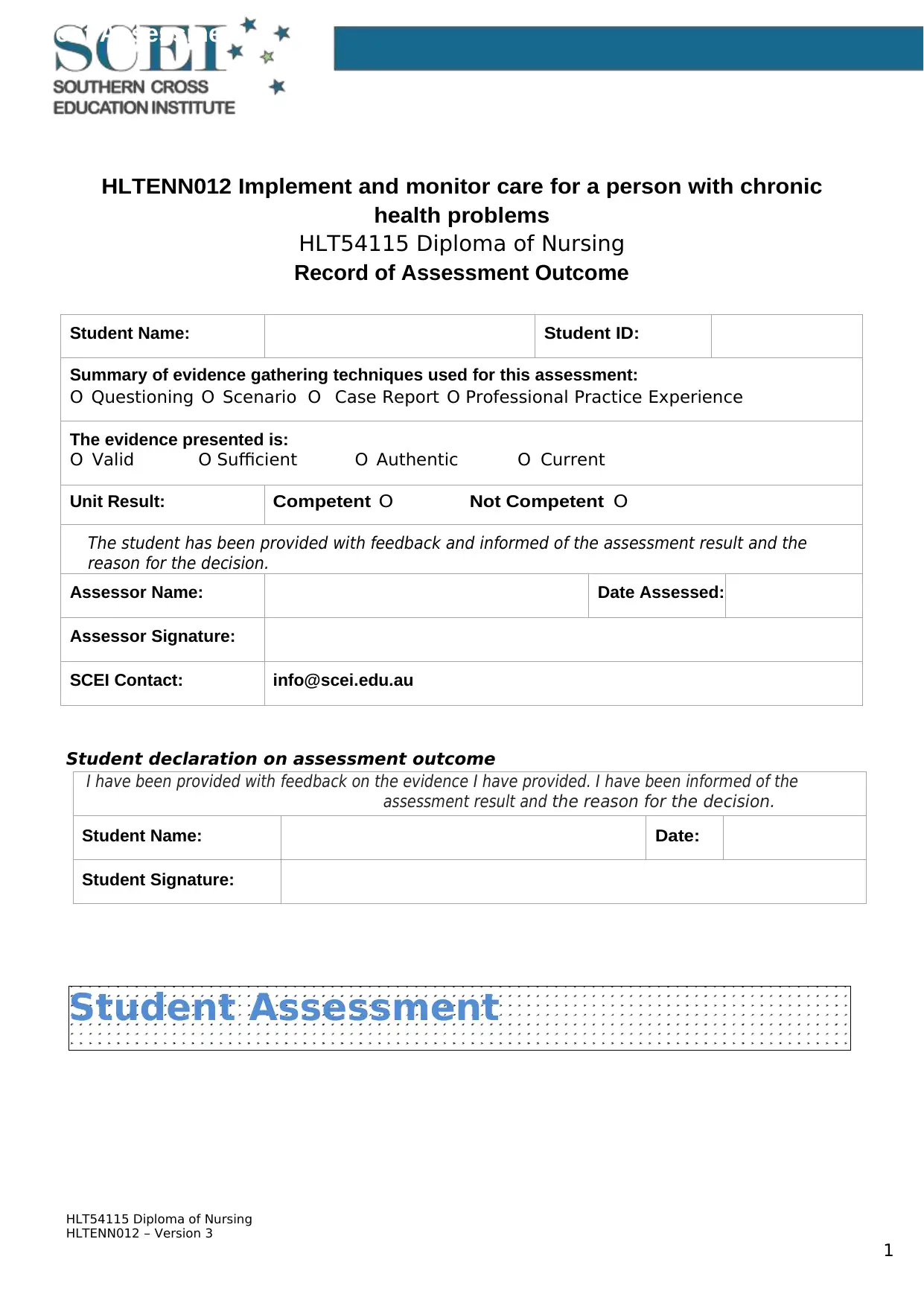
HLT54115 Diploma of Nursing
HLTENN012 – Version 3
January 2019 1
Student Assessment
Student Assessment
HLTENN012 Implement and monitor care for a person with chronic
health problems
HLT54115 Diploma of Nursing
Record of Assessment Outcome
Student Name: Student ID:
Summary of evidence gathering techniques used for this assessment:
O Questioning O Scenario O Case Report O Professional Practice Experience
The evidence presented is:
O Valid O Sufficient O Authentic O Current
Unit Result: Competent O Not Competent O
The student has been provided with feedback and informed of the assessment result and the
reason for the decision.
Assessor Name: Date Assessed:
Assessor Signature:
SCEI Contact: info@scei.edu.au
Student declaration on assessment outcome
I have been provided with feedback on the evidence I have provided. I have been informed of the
assessment result and the reason for the decision.
Student Name: Date:
Student Signature:
HLTENN012 – Version 3
January 2019 1
Student Assessment
Student Assessment
HLTENN012 Implement and monitor care for a person with chronic
health problems
HLT54115 Diploma of Nursing
Record of Assessment Outcome
Student Name: Student ID:
Summary of evidence gathering techniques used for this assessment:
O Questioning O Scenario O Case Report O Professional Practice Experience
The evidence presented is:
O Valid O Sufficient O Authentic O Current
Unit Result: Competent O Not Competent O
The student has been provided with feedback and informed of the assessment result and the
reason for the decision.
Assessor Name: Date Assessed:
Assessor Signature:
SCEI Contact: info@scei.edu.au
Student declaration on assessment outcome
I have been provided with feedback on the evidence I have provided. I have been informed of the
assessment result and the reason for the decision.
Student Name: Date:
Student Signature:
Paraphrase This Document
Need a fresh take? Get an instant paraphrase of this document with our AI Paraphraser
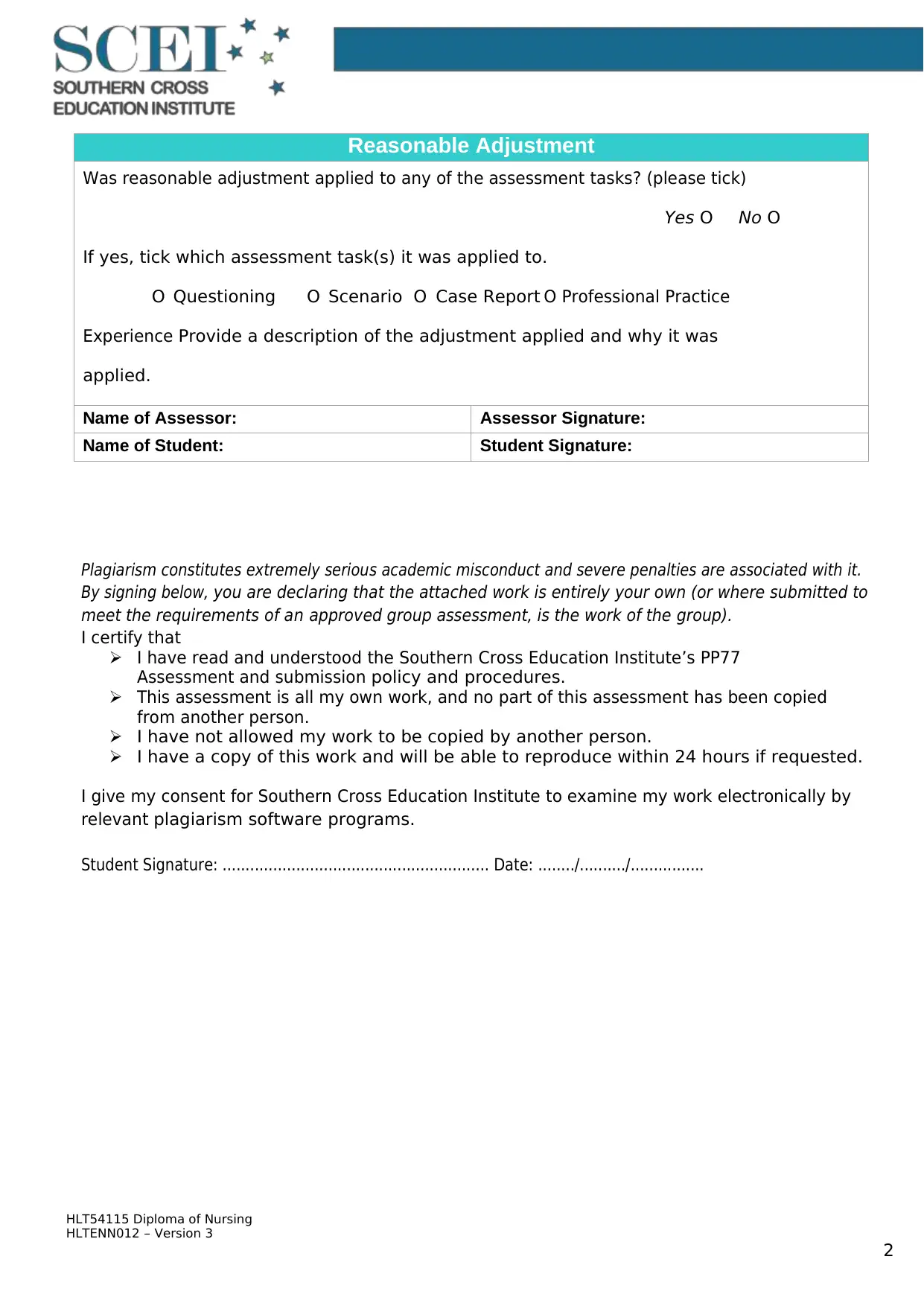
Plagiarism constitutes extremely serious academic misconduct and severe penalties are associated with it.
By signing below, you are declaring that the attached work is entirely your own (or where submitted to
meet the requirements of an approved group assessment, is the work of the group).
I certify that
I have read and understood the Southern Cross Education Institute’s PP77
Assessment and submission policy and procedures.
This assessment is all my own work, and no part of this assessment has been copied
from another person.
I have not allowed my work to be copied by another person.
I have a copy of this work and will be able to reproduce within 24 hours if requested.
I give my consent for Southern Cross Education Institute to examine my work electronically by
relevant plagiarism software programs.
Student Signature: .......................................................... Date: ......../........../................
2
HLT54115 Diploma of Nursing
HLTENN012 – Version 3
January 2019
Reasonable Adjustment
Was reasonable adjustment applied to any of the assessment tasks? (please tick)
Yes O No O
If yes, tick which assessment task(s) it was applied to.
O Questioning O Scenario O Case Report O Professional Practice
Experience Provide a description of the adjustment applied and why it was
applied.
Name of Assessor: Assessor Signature:
Name of Student: Student Signature:
Student
By signing below, you are declaring that the attached work is entirely your own (or where submitted to
meet the requirements of an approved group assessment, is the work of the group).
I certify that
I have read and understood the Southern Cross Education Institute’s PP77
Assessment and submission policy and procedures.
This assessment is all my own work, and no part of this assessment has been copied
from another person.
I have not allowed my work to be copied by another person.
I have a copy of this work and will be able to reproduce within 24 hours if requested.
I give my consent for Southern Cross Education Institute to examine my work electronically by
relevant plagiarism software programs.
Student Signature: .......................................................... Date: ......../........../................
2
HLT54115 Diploma of Nursing
HLTENN012 – Version 3
January 2019
Reasonable Adjustment
Was reasonable adjustment applied to any of the assessment tasks? (please tick)
Yes O No O
If yes, tick which assessment task(s) it was applied to.
O Questioning O Scenario O Case Report O Professional Practice
Experience Provide a description of the adjustment applied and why it was
applied.
Name of Assessor: Assessor Signature:
Name of Student: Student Signature:
Student
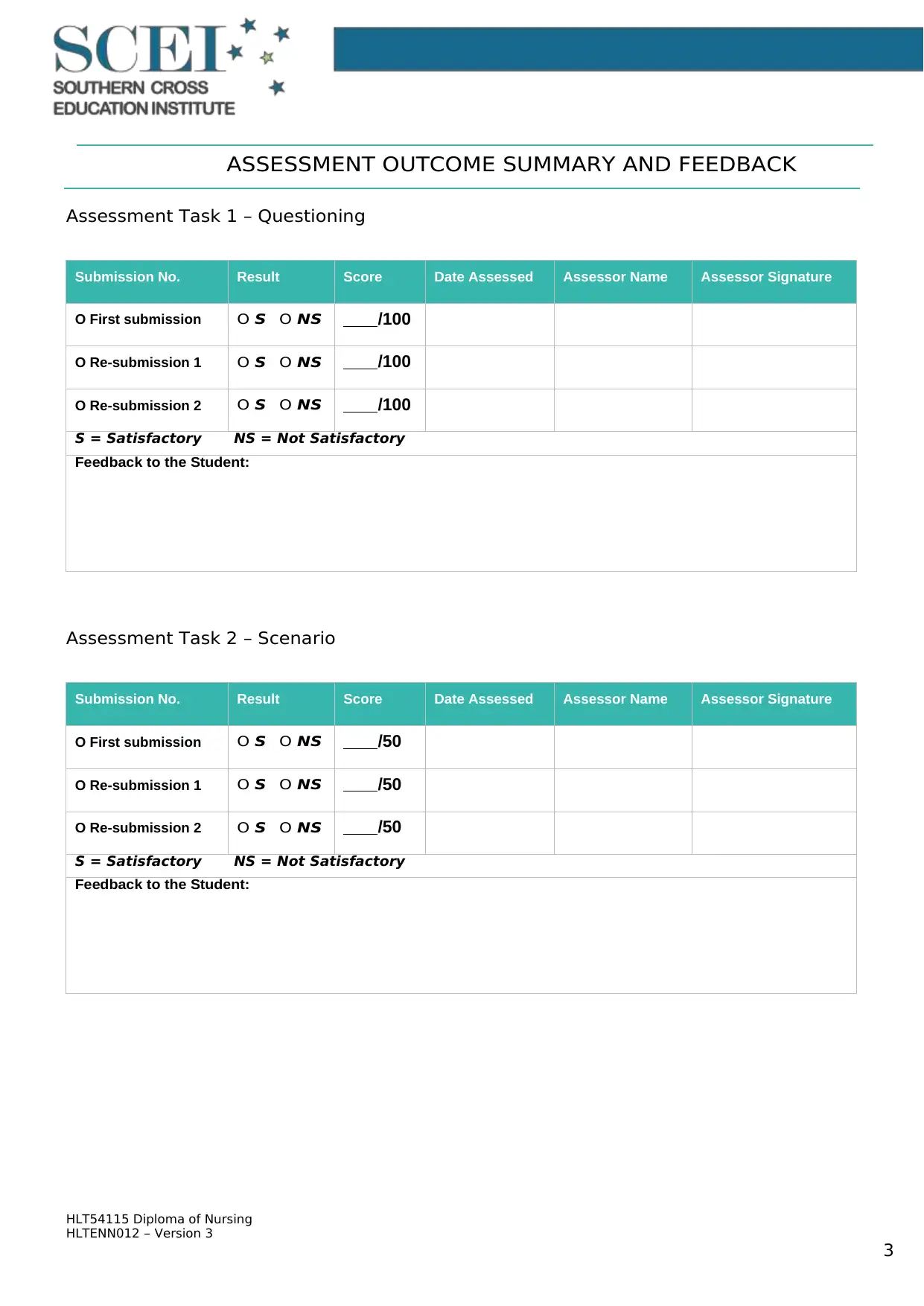
3
HLT54115 Diploma of Nursing
HLTENN012 – Version 3
January 2019
ASSESSMENT OUTCOME SUMMARY AND FEEDBACK
Assessment Task 1 – Questioning
Submission No. Result Score Date Assessed Assessor Name Assessor Signature
O First submission O S O NS /100
O Re-submission 1 O S O NS /100
O Re-submission 2 O S O NS /100
S = Satisfactory NS = Not Satisfactory
Feedback to the Student:
Assessment Task 2 – Scenario
Submission No. Result Score Date Assessed Assessor Name Assessor Signature
O First submission O S O NS /50
O Re-submission 1 O S O NS /50
O Re-submission 2 O S O NS /50
S = Satisfactory NS = Not Satisfactory
Feedback to the Student:
HLT54115 Diploma of Nursing
HLTENN012 – Version 3
January 2019
ASSESSMENT OUTCOME SUMMARY AND FEEDBACK
Assessment Task 1 – Questioning
Submission No. Result Score Date Assessed Assessor Name Assessor Signature
O First submission O S O NS /100
O Re-submission 1 O S O NS /100
O Re-submission 2 O S O NS /100
S = Satisfactory NS = Not Satisfactory
Feedback to the Student:
Assessment Task 2 – Scenario
Submission No. Result Score Date Assessed Assessor Name Assessor Signature
O First submission O S O NS /50
O Re-submission 1 O S O NS /50
O Re-submission 2 O S O NS /50
S = Satisfactory NS = Not Satisfactory
Feedback to the Student:
⊘ This is a preview!⊘
Do you want full access?
Subscribe today to unlock all pages.

Trusted by 1+ million students worldwide
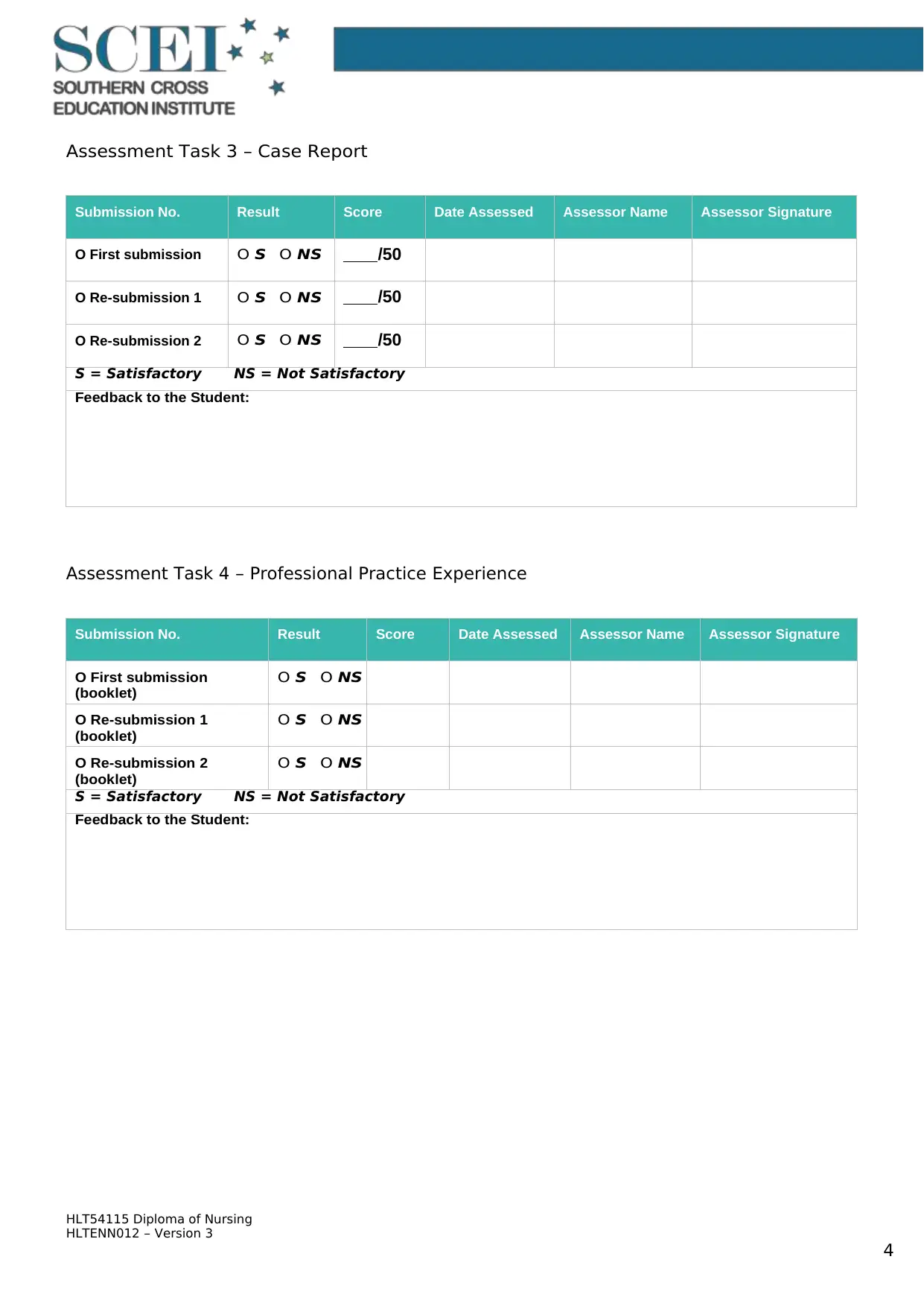
4
HLT54115 Diploma of Nursing
HLTENN012 – Version 3
January 2019
Assessment Task 3 – Case Report
Submission No. Result Score Date Assessed Assessor Name Assessor Signature
O First submission O S O NS /50
O Re-submission 1 O S O NS /50
O Re-submission 2 O S O NS /50
S = Satisfactory NS = Not Satisfactory
Feedback to the Student:
Assessment Task 4 – Professional Practice Experience
Submission No. Result Score Date Assessed Assessor Name Assessor Signature
O First submission
(booklet)
O S O NS
O Re-submission 1
(booklet)
O S O NS
O Re-submission 2
(booklet)
O S O NS
S = Satisfactory NS = Not Satisfactory
Feedback to the Student:
HLT54115 Diploma of Nursing
HLTENN012 – Version 3
January 2019
Assessment Task 3 – Case Report
Submission No. Result Score Date Assessed Assessor Name Assessor Signature
O First submission O S O NS /50
O Re-submission 1 O S O NS /50
O Re-submission 2 O S O NS /50
S = Satisfactory NS = Not Satisfactory
Feedback to the Student:
Assessment Task 4 – Professional Practice Experience
Submission No. Result Score Date Assessed Assessor Name Assessor Signature
O First submission
(booklet)
O S O NS
O Re-submission 1
(booklet)
O S O NS
O Re-submission 2
(booklet)
O S O NS
S = Satisfactory NS = Not Satisfactory
Feedback to the Student:
Paraphrase This Document
Need a fresh take? Get an instant paraphrase of this document with our AI Paraphraser
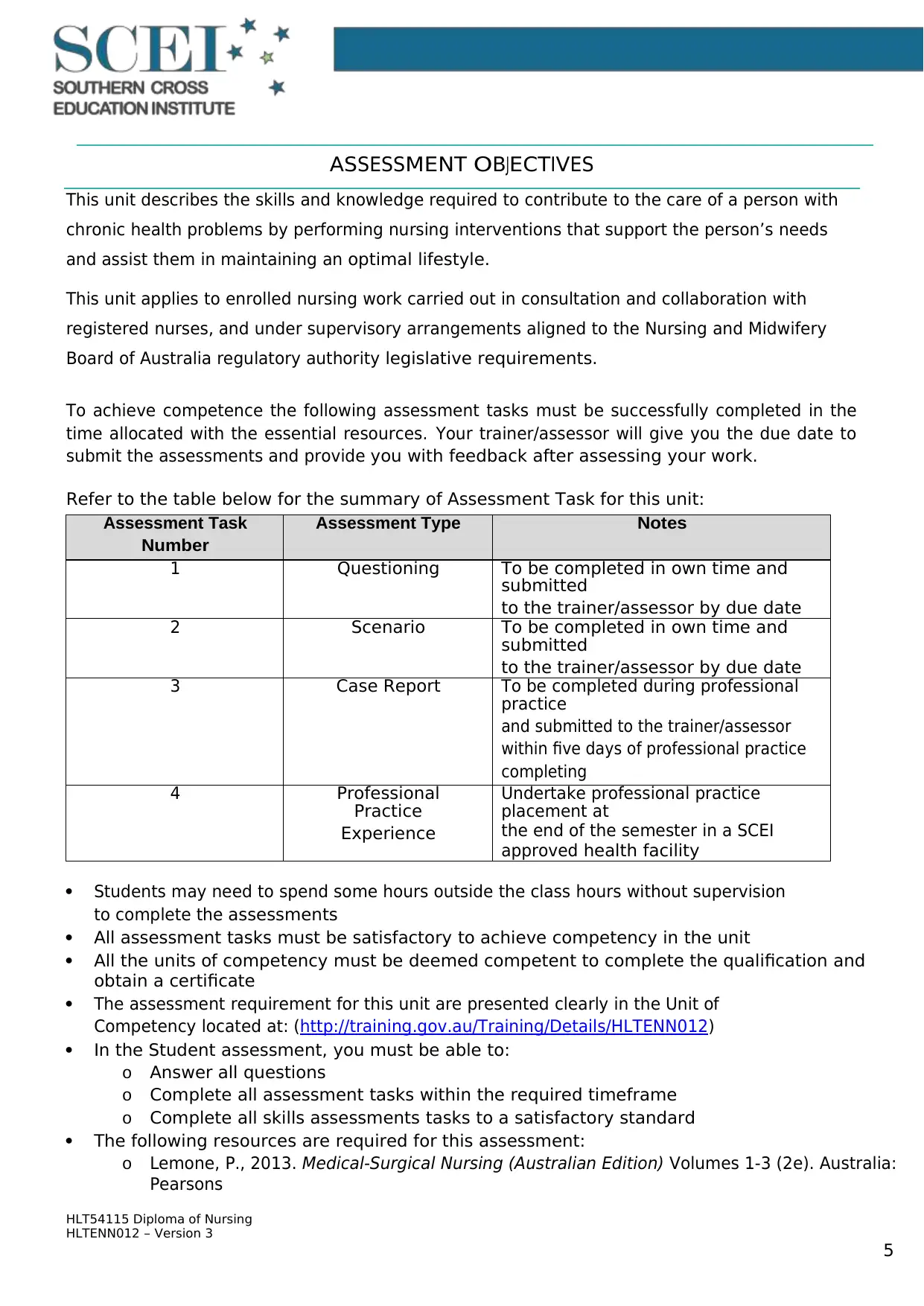
5
HLT54115 Diploma of Nursing
HLTENN012 – Version 3
January 2019
AS S ES S M EN T OBJ EC T I V E S
This unit describes the skills and knowledge required to contribute to the care of a person with
chronic health problems by performing nursing interventions that support the person’s needs
and assist them in maintaining an optimal lifestyle.
This unit applies to enrolled nursing work carried out in consultation and collaboration with
registered nurses, and under supervisory arrangements aligned to the Nursing and Midwifery
Board of Australia regulatory authority legislative requirements.
To achieve competence the following assessment tasks must be successfully completed in the
time allocated with the essential resources. Your trainer/assessor will give you the due date to
submit the assessments and provide you with feedback after assessing your work.
Refer to the table below for the summary of Assessment Task for this unit:
Assessment Task
Number
Assessment Type Notes
1 Questioning To be completed in own time and
submitted
to the trainer/assessor by due date
2 Scenario To be completed in own time and
submitted
to the trainer/assessor by due date
3 Case Report To be completed during professional
practice
and submitted to the trainer/assessor
within five days of professional practice
completing
4 Professional
Practice
Experience
Undertake professional practice
placement at
the end of the semester in a SCEI
approved health facility
Students may need to spend some hours outside the class hours without supervision
to complete the assessments
All assessment tasks must be satisfactory to achieve competency in the unit
All the units of competency must be deemed competent to complete the qualification and
obtain a certificate
The assessment requirement for this unit are presented clearly in the Unit of
Competency located at: (http://training.gov.au/Training/Details/HLTENN012)
In the Student assessment, you must be able to:
o Answer all questions
o Complete all assessment tasks within the required timeframe
o Complete all skills assessments tasks to a satisfactory standard
The following resources are required for this assessment:
o Lemone, P., 2013. Medical-Surgical Nursing (Australian Edition) Volumes 1-3 (2e). Australia:
Pearsons
HLT54115 Diploma of Nursing
HLTENN012 – Version 3
January 2019
AS S ES S M EN T OBJ EC T I V E S
This unit describes the skills and knowledge required to contribute to the care of a person with
chronic health problems by performing nursing interventions that support the person’s needs
and assist them in maintaining an optimal lifestyle.
This unit applies to enrolled nursing work carried out in consultation and collaboration with
registered nurses, and under supervisory arrangements aligned to the Nursing and Midwifery
Board of Australia regulatory authority legislative requirements.
To achieve competence the following assessment tasks must be successfully completed in the
time allocated with the essential resources. Your trainer/assessor will give you the due date to
submit the assessments and provide you with feedback after assessing your work.
Refer to the table below for the summary of Assessment Task for this unit:
Assessment Task
Number
Assessment Type Notes
1 Questioning To be completed in own time and
submitted
to the trainer/assessor by due date
2 Scenario To be completed in own time and
submitted
to the trainer/assessor by due date
3 Case Report To be completed during professional
practice
and submitted to the trainer/assessor
within five days of professional practice
completing
4 Professional
Practice
Experience
Undertake professional practice
placement at
the end of the semester in a SCEI
approved health facility
Students may need to spend some hours outside the class hours without supervision
to complete the assessments
All assessment tasks must be satisfactory to achieve competency in the unit
All the units of competency must be deemed competent to complete the qualification and
obtain a certificate
The assessment requirement for this unit are presented clearly in the Unit of
Competency located at: (http://training.gov.au/Training/Details/HLTENN012)
In the Student assessment, you must be able to:
o Answer all questions
o Complete all assessment tasks within the required timeframe
o Complete all skills assessments tasks to a satisfactory standard
The following resources are required for this assessment:
o Lemone, P., 2013. Medical-Surgical Nursing (Australian Edition) Volumes 1-3 (2e). Australia:
Pearsons
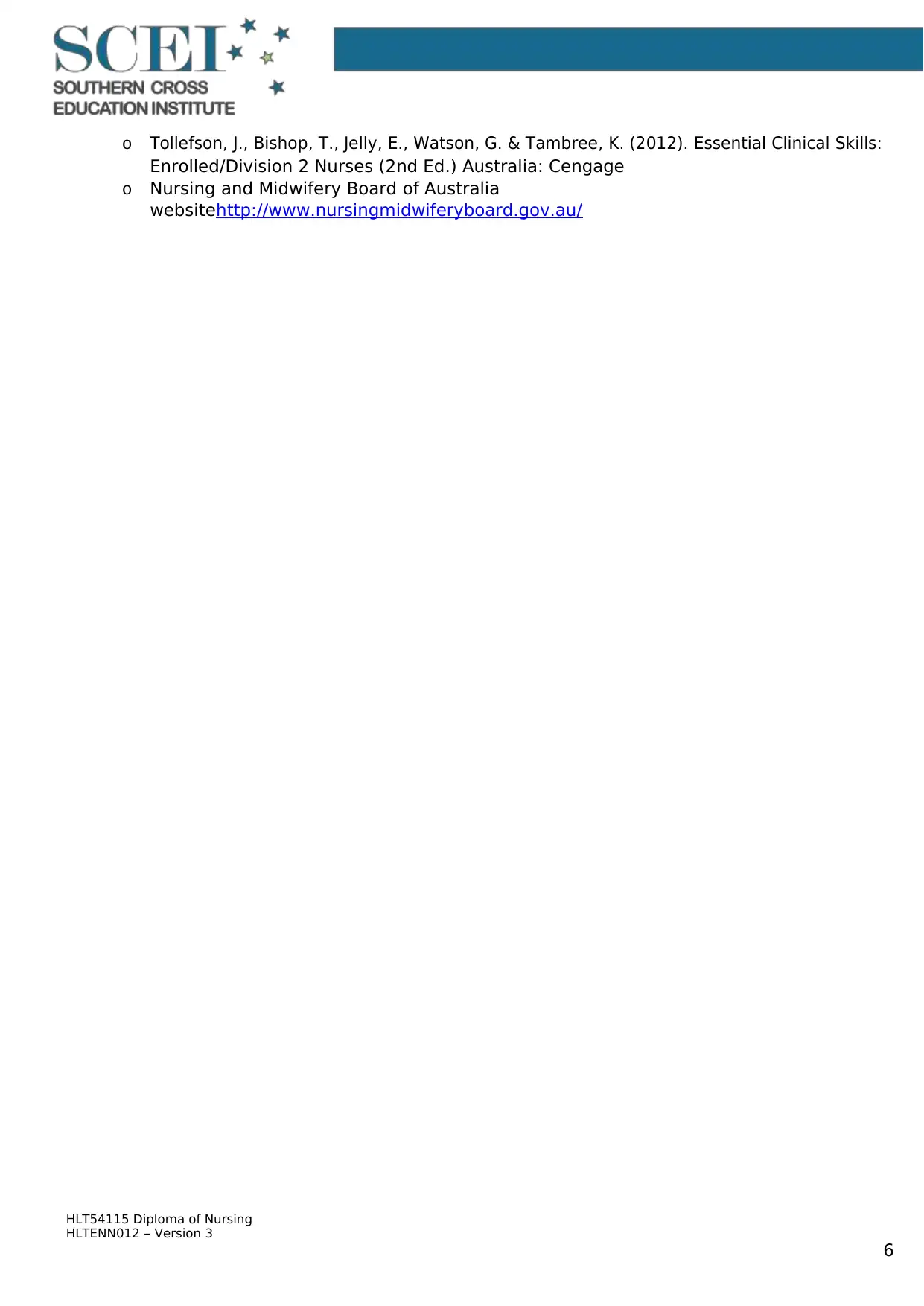
6
HLT54115 Diploma of Nursing
HLTENN012 – Version 3
January 2019
o Tollefson, J., Bishop, T., Jelly, E., Watson, G. & Tambree, K. (2012). Essential Clinical Skills:
Enrolled/Division 2 Nurses (2nd Ed.) Australia: Cengage
o Nursing and Midwifery Board of Australia
websitehttp://www.nursingmidwiferyboard.gov.au/
HLT54115 Diploma of Nursing
HLTENN012 – Version 3
January 2019
o Tollefson, J., Bishop, T., Jelly, E., Watson, G. & Tambree, K. (2012). Essential Clinical Skills:
Enrolled/Division 2 Nurses (2nd Ed.) Australia: Cengage
o Nursing and Midwifery Board of Australia
websitehttp://www.nursingmidwiferyboard.gov.au/
⊘ This is a preview!⊘
Do you want full access?
Subscribe today to unlock all pages.

Trusted by 1+ million students worldwide
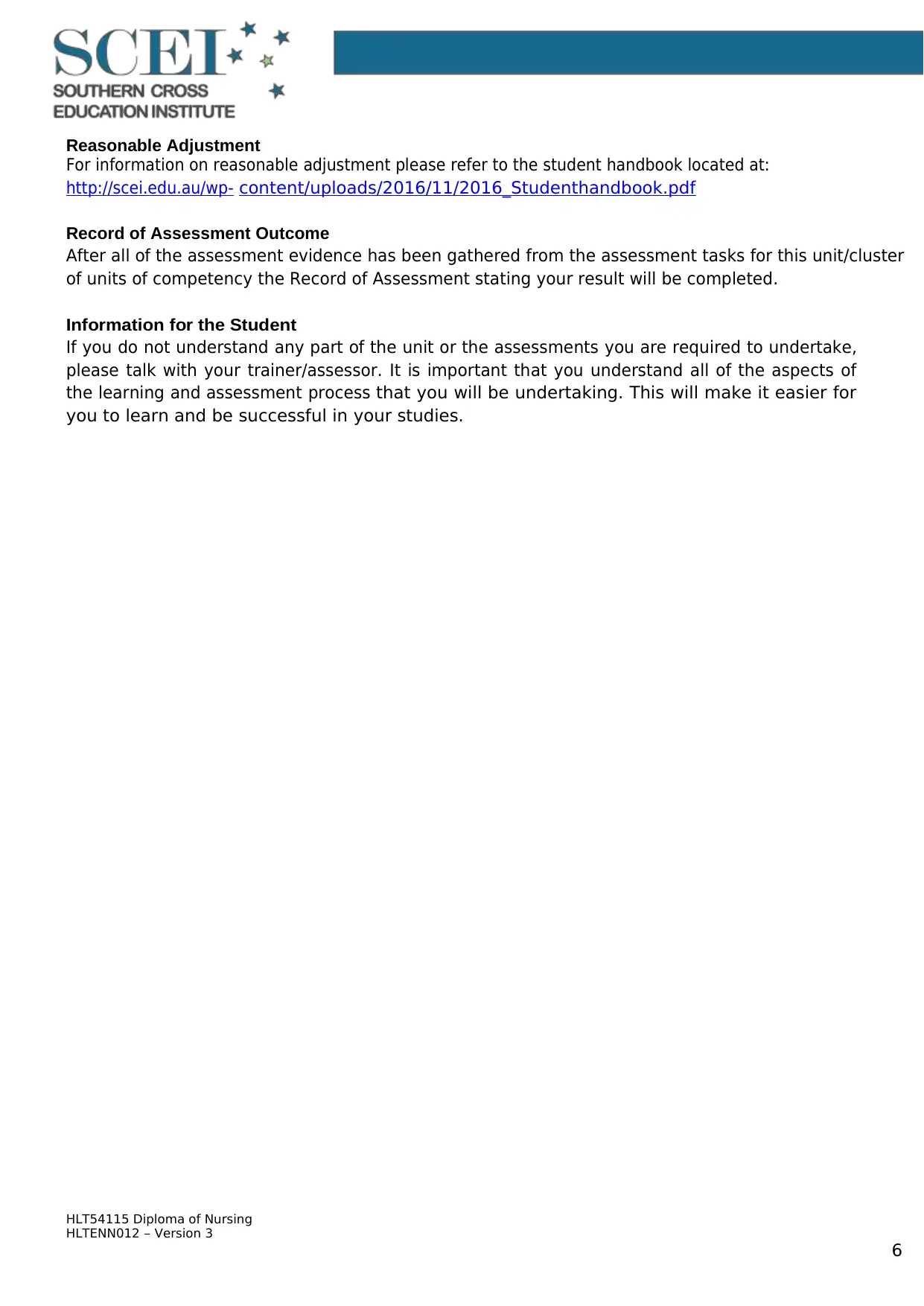
6
HLT54115 Diploma of Nursing
HLTENN012 – Version 3
January 2019
Reasonable Adjustment
For information on reasonable adjustment please refer to the student handbook located at:
http://scei.edu.au/wp- content/uploads/2016/11/2016_Studenthandbook.pdf
Record of Assessment Outcome
After all of the assessment evidence has been gathered from the assessment tasks for this unit/cluster
of units of competency the Record of Assessment stating your result will be completed.
Information for the Student
If you do not understand any part of the unit or the assessments you are required to undertake,
please talk with your trainer/assessor. It is important that you understand all of the aspects of
the learning and assessment process that you will be undertaking. This will make it easier for
you to learn and be successful in your studies.
HLT54115 Diploma of Nursing
HLTENN012 – Version 3
January 2019
Reasonable Adjustment
For information on reasonable adjustment please refer to the student handbook located at:
http://scei.edu.au/wp- content/uploads/2016/11/2016_Studenthandbook.pdf
Record of Assessment Outcome
After all of the assessment evidence has been gathered from the assessment tasks for this unit/cluster
of units of competency the Record of Assessment stating your result will be completed.
Information for the Student
If you do not understand any part of the unit or the assessments you are required to undertake,
please talk with your trainer/assessor. It is important that you understand all of the aspects of
the learning and assessment process that you will be undertaking. This will make it easier for
you to learn and be successful in your studies.
Paraphrase This Document
Need a fresh take? Get an instant paraphrase of this document with our AI Paraphraser
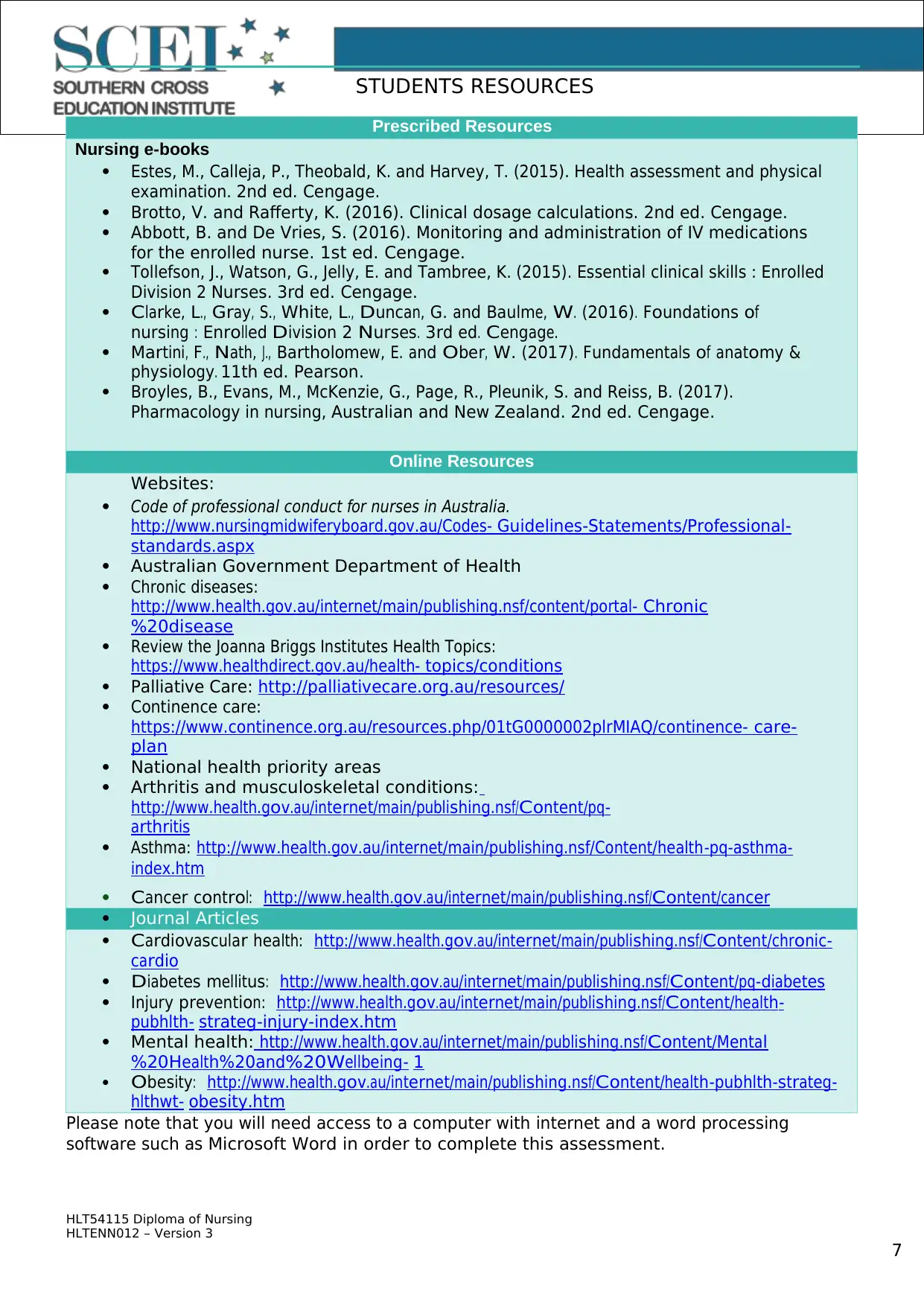
7
HLT54115 Diploma of Nursing
HLTENN012 – Version 3
January 2019
STUDENTS RESOURCES
Prescribed Resources
Nursing e-books
Estes, M., Calleja, P., Theobald, K. and Harvey, T. (2015). Health assessment and physical
examination. 2nd ed. Cengage.
Brotto, V. and Rafferty, K. (2016). Clinical dosage calculations. 2nd ed. Cengage.
Abbott, B. and De Vries, S. (2016). Monitoring and administration of IV medications
for the enrolled nurse. 1st ed. Cengage.
Tollefson, J., Watson, G., Jelly, E. and Tambree, K. (2015). Essential clinical skills : Enrolled
Division 2 Nurses. 3rd ed. Cengage.
C la rke, L ., Gra y , S. , White, L ., D unc a n, G. a nd Ba ulm e, W. (2016) . Found a tio ns of
nur s in g : Enr oll ed D iv is io n 2 Nur s es . 3rd ed . C eng a g e.
Ma rtini , F ., Na th, J ., Ba rtholom ew, E. a nd Ober, W. ( 2017) . F unda m ent a l s of a na tomy &
phy s io log y . 11th ed. Pearson.
Broyles, B., Evans, M., McKenzie, G., Page, R., Pleunik, S. and Reiss, B. (2017).
Pharmacology in nursing, Australian and New Zealand. 2nd ed. Cengage.
Online Resources
Websites:
Code of professional conduct for nurses in Australia.
http://www.nursingmidwiferyboard.gov.au/Codes- Guidelines-Statements/Professional-
standards.aspx
Australian Government Department of Health
Chronic diseases:
http://www.health.gov.au/internet/main/publishing.nsf/content/portal- Chronic
%20disease
Review the Joanna Briggs Institutes Health Topics:
https://www.healthdirect.gov.au/health- topics/conditions
Palliative Care: http://palliativecare.org.au/resources/
Continence care:
https://www.continence.org.au/resources.php/01tG0000002plrMIAQ/continence- care-
plan
National health priority areas
Arthritis and musculoskeletal conditions:
http://ww w.he al th. g ov.a u/in te rnet/m a in/publi s hing .n s f / C ontent/p q -
arth ritis
Asthma: http://www.health.gov.au/internet/main/publishing.nsf/Content/health-pq-asthma-
index.htm
C a ncer c ont rol: http://ww w.he alt h.g ov .a u/in t er net/ ma in/publi s hing . n s f /C ontent/c a n cer
Journal Articles
C a rdio va s c ula r hea lt h: http://ww w.h e a lt h.g ov .a u/in t er net/ ma in/publi s hing . n s f /C ontent/ch r oni c -
ca rdio
D ia betes mellit us : http://ww w.he al th . g ov.a u/in te rnet/m a in/publi s hin g .n s f / C ontent/p q -d i a be tes
I njur y pr event io n: http://ww w.he alt h.g ov .a u/in te rnet/m a in/publi s hin g .n s f / C ontent/he a l th -
pubhlth - strateg-injury-index.htm
Mental health: http://www.health.gov.au/internet/main/publishing.nsf/Content/Mental
%20Health%20and%20Wellbeing- 1
Obes it y : http://ww w.he al th . g ov.a u/in te rnet/m a in/publ i s hin g .n s f /C ontent/he a lt h -pubhlth -s tra teg -
hlthw t - obesity.htm
Please note that you will need access to a computer with internet and a word processing
software such as Microsoft Word in order to complete this assessment.
HLT54115 Diploma of Nursing
HLTENN012 – Version 3
January 2019
STUDENTS RESOURCES
Prescribed Resources
Nursing e-books
Estes, M., Calleja, P., Theobald, K. and Harvey, T. (2015). Health assessment and physical
examination. 2nd ed. Cengage.
Brotto, V. and Rafferty, K. (2016). Clinical dosage calculations. 2nd ed. Cengage.
Abbott, B. and De Vries, S. (2016). Monitoring and administration of IV medications
for the enrolled nurse. 1st ed. Cengage.
Tollefson, J., Watson, G., Jelly, E. and Tambree, K. (2015). Essential clinical skills : Enrolled
Division 2 Nurses. 3rd ed. Cengage.
C la rke, L ., Gra y , S. , White, L ., D unc a n, G. a nd Ba ulm e, W. (2016) . Found a tio ns of
nur s in g : Enr oll ed D iv is io n 2 Nur s es . 3rd ed . C eng a g e.
Ma rtini , F ., Na th, J ., Ba rtholom ew, E. a nd Ober, W. ( 2017) . F unda m ent a l s of a na tomy &
phy s io log y . 11th ed. Pearson.
Broyles, B., Evans, M., McKenzie, G., Page, R., Pleunik, S. and Reiss, B. (2017).
Pharmacology in nursing, Australian and New Zealand. 2nd ed. Cengage.
Online Resources
Websites:
Code of professional conduct for nurses in Australia.
http://www.nursingmidwiferyboard.gov.au/Codes- Guidelines-Statements/Professional-
standards.aspx
Australian Government Department of Health
Chronic diseases:
http://www.health.gov.au/internet/main/publishing.nsf/content/portal- Chronic
%20disease
Review the Joanna Briggs Institutes Health Topics:
https://www.healthdirect.gov.au/health- topics/conditions
Palliative Care: http://palliativecare.org.au/resources/
Continence care:
https://www.continence.org.au/resources.php/01tG0000002plrMIAQ/continence- care-
plan
National health priority areas
Arthritis and musculoskeletal conditions:
http://ww w.he al th. g ov.a u/in te rnet/m a in/publi s hing .n s f / C ontent/p q -
arth ritis
Asthma: http://www.health.gov.au/internet/main/publishing.nsf/Content/health-pq-asthma-
index.htm
C a ncer c ont rol: http://ww w.he alt h.g ov .a u/in t er net/ ma in/publi s hing . n s f /C ontent/c a n cer
Journal Articles
C a rdio va s c ula r hea lt h: http://ww w.h e a lt h.g ov .a u/in t er net/ ma in/publi s hing . n s f /C ontent/ch r oni c -
ca rdio
D ia betes mellit us : http://ww w.he al th . g ov.a u/in te rnet/m a in/publi s hin g .n s f / C ontent/p q -d i a be tes
I njur y pr event io n: http://ww w.he alt h.g ov .a u/in te rnet/m a in/publi s hin g .n s f / C ontent/he a l th -
pubhlth - strateg-injury-index.htm
Mental health: http://www.health.gov.au/internet/main/publishing.nsf/Content/Mental
%20Health%20and%20Wellbeing- 1
Obes it y : http://ww w.he al th . g ov.a u/in te rnet/m a in/publ i s hin g .n s f /C ontent/he a lt h -pubhlth -s tra teg -
hlthw t - obesity.htm
Please note that you will need access to a computer with internet and a word processing
software such as Microsoft Word in order to complete this assessment.
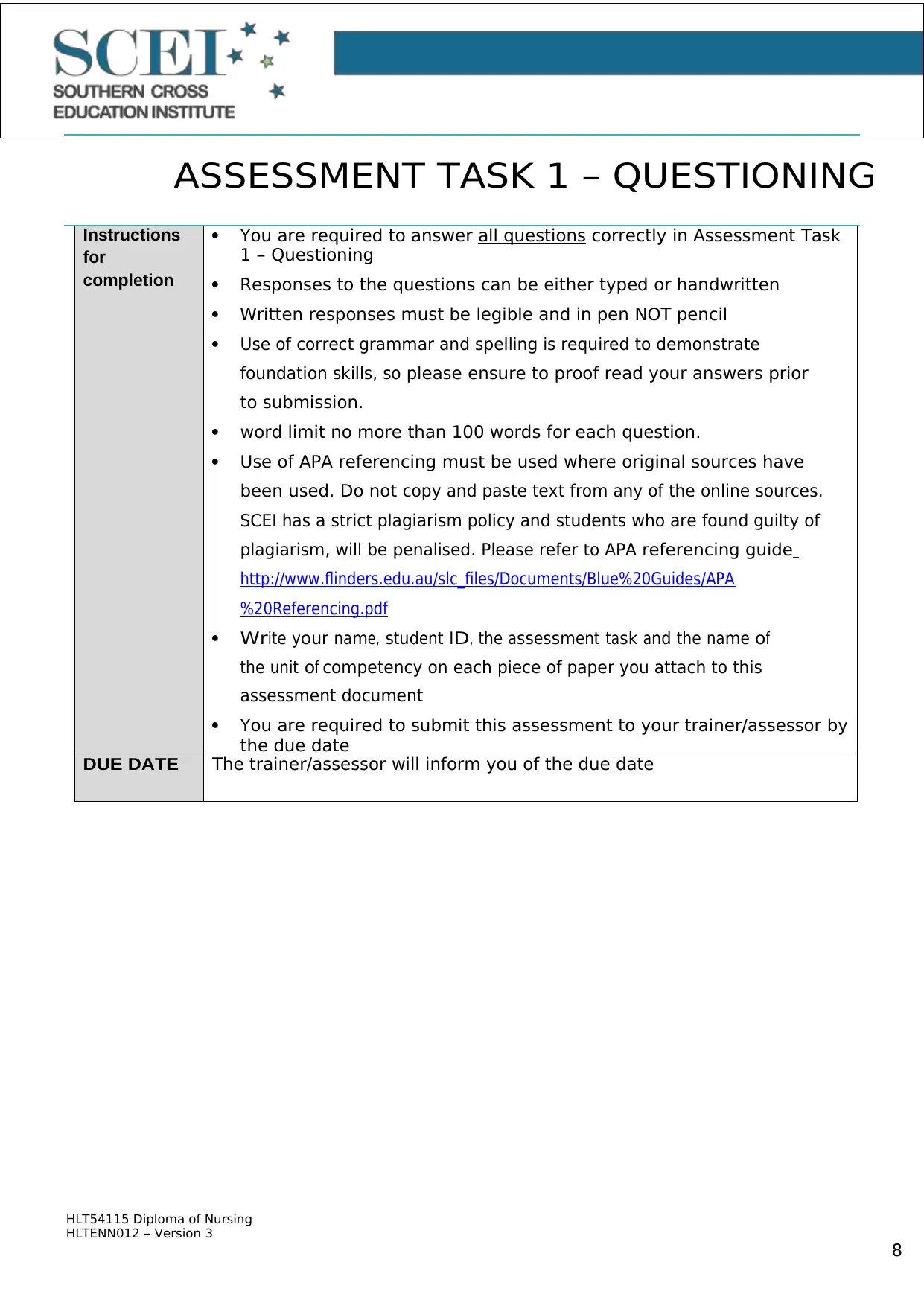
8
HLT54115 Diploma of Nursing
HLTENN012 – Version 3
January 2019
ASSESSMENT TASK 1 – QUESTIONING
Instructions
for
completion
You are required to answer all questions correctly in Assessment Task
1 – Questioning
Responses to the questions can be either typed or handwritten
Written responses must be legible and in pen NOT pencil
Use of correct grammar and spelling is required to demonstrate
foundation skills, so please ensure to proof read your answers prior
to submission.
word limit no more than 100 words for each question.
Use of APA referencing must be used where original sources have
been used. Do not copy and paste text from any of the online sources.
SCEI has a strict plagiarism policy and students who are found guilty of
plagiarism, will be penalised. Please refer to APA referencing guide
http://www.flinders.edu.au/slc_files/Documents/Blue%20Guides/APA
%20Referencing.pdf
Writ e your na me, s tudent ID , the a ss ess m ent ta sk a nd the na m e of
the unit of competency on each piece of paper you attach to this
assessment document
You are required to submit this assessment to your trainer/assessor by
the due date
DUE DATE The trainer/assessor will inform you of the due date
HLT54115 Diploma of Nursing
HLTENN012 – Version 3
January 2019
ASSESSMENT TASK 1 – QUESTIONING
Instructions
for
completion
You are required to answer all questions correctly in Assessment Task
1 – Questioning
Responses to the questions can be either typed or handwritten
Written responses must be legible and in pen NOT pencil
Use of correct grammar and spelling is required to demonstrate
foundation skills, so please ensure to proof read your answers prior
to submission.
word limit no more than 100 words for each question.
Use of APA referencing must be used where original sources have
been used. Do not copy and paste text from any of the online sources.
SCEI has a strict plagiarism policy and students who are found guilty of
plagiarism, will be penalised. Please refer to APA referencing guide
http://www.flinders.edu.au/slc_files/Documents/Blue%20Guides/APA
%20Referencing.pdf
Writ e your na me, s tudent ID , the a ss ess m ent ta sk a nd the na m e of
the unit of competency on each piece of paper you attach to this
assessment document
You are required to submit this assessment to your trainer/assessor by
the due date
DUE DATE The trainer/assessor will inform you of the due date
⊘ This is a preview!⊘
Do you want full access?
Subscribe today to unlock all pages.

Trusted by 1+ million students worldwide
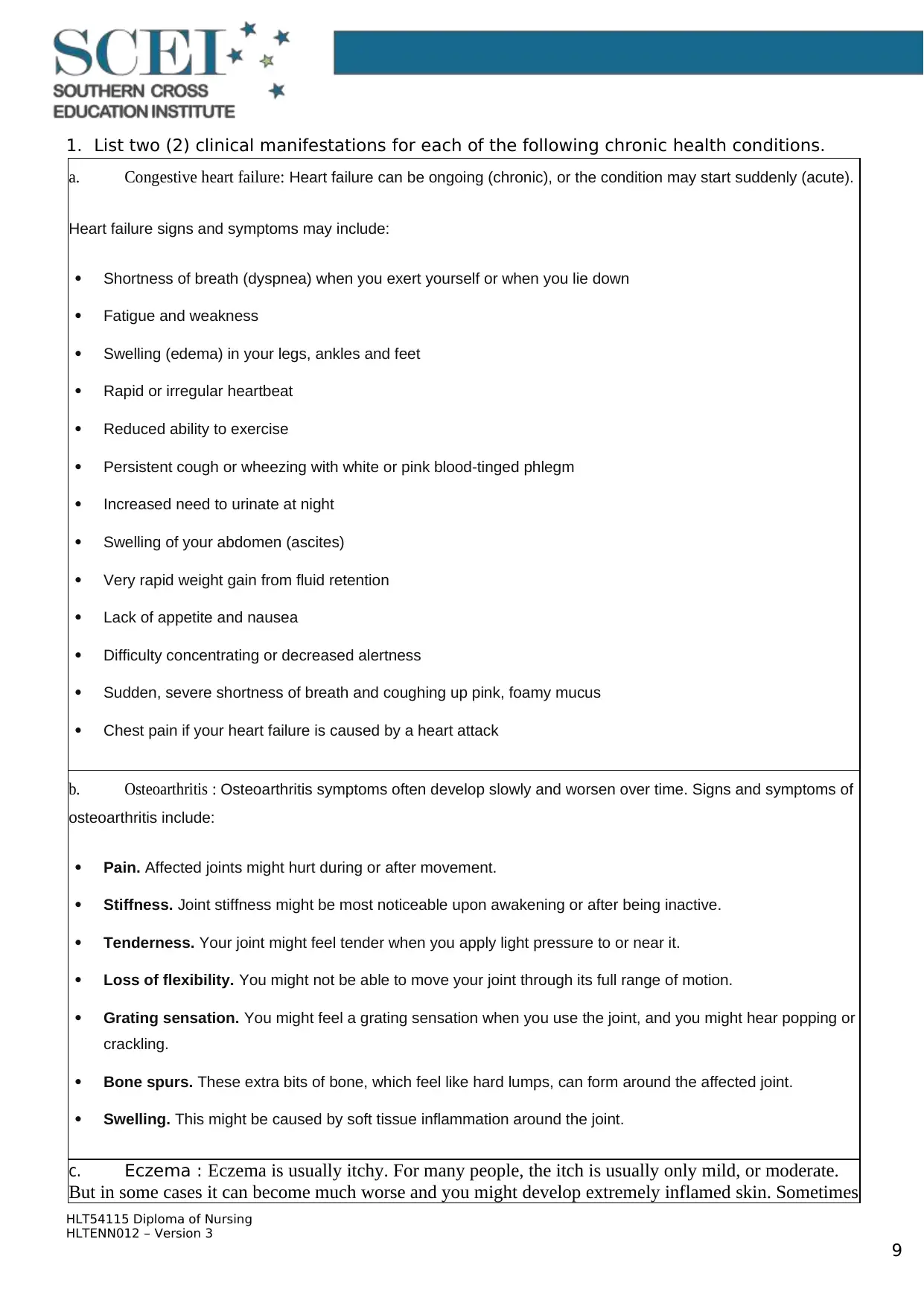
9
HLT54115 Diploma of Nursing
HLTENN012 – Version 3
January 2019
1. List two (2) clinical manifestations for each of the following chronic health conditions.
a. Congestive heart failure: Heart failure can be ongoing (chronic), or the condition may start suddenly (acute).
Heart failure signs and symptoms may include:
Shortness of breath (dyspnea) when you exert yourself or when you lie down
Fatigue and weakness
Swelling (edema) in your legs, ankles and feet
Rapid or irregular heartbeat
Reduced ability to exercise
Persistent cough or wheezing with white or pink blood-tinged phlegm
Increased need to urinate at night
Swelling of your abdomen (ascites)
Very rapid weight gain from fluid retention
Lack of appetite and nausea
Difficulty concentrating or decreased alertness
Sudden, severe shortness of breath and coughing up pink, foamy mucus
Chest pain if your heart failure is caused by a heart attack
b. Osteoarthritis : Osteoarthritis symptoms often develop slowly and worsen over time. Signs and symptoms of
osteoarthritis include:
Pain. Affected joints might hurt during or after movement.
Stiffness. Joint stiffness might be most noticeable upon awakening or after being inactive.
Tenderness. Your joint might feel tender when you apply light pressure to or near it.
Loss of flexibility. You might not be able to move your joint through its full range of motion.
Grating sensation. You might feel a grating sensation when you use the joint, and you might hear popping or
crackling.
Bone spurs. These extra bits of bone, which feel like hard lumps, can form around the affected joint.
Swelling. This might be caused by soft tissue inflammation around the joint.
c. Eczema : Eczema is usually itchy. For many people, the itch is usually only mild, or moderate.
But in some cases it can become much worse and you might develop extremely inflamed skin. Sometimes
HLT54115 Diploma of Nursing
HLTENN012 – Version 3
January 2019
1. List two (2) clinical manifestations for each of the following chronic health conditions.
a. Congestive heart failure: Heart failure can be ongoing (chronic), or the condition may start suddenly (acute).
Heart failure signs and symptoms may include:
Shortness of breath (dyspnea) when you exert yourself or when you lie down
Fatigue and weakness
Swelling (edema) in your legs, ankles and feet
Rapid or irregular heartbeat
Reduced ability to exercise
Persistent cough or wheezing with white or pink blood-tinged phlegm
Increased need to urinate at night
Swelling of your abdomen (ascites)
Very rapid weight gain from fluid retention
Lack of appetite and nausea
Difficulty concentrating or decreased alertness
Sudden, severe shortness of breath and coughing up pink, foamy mucus
Chest pain if your heart failure is caused by a heart attack
b. Osteoarthritis : Osteoarthritis symptoms often develop slowly and worsen over time. Signs and symptoms of
osteoarthritis include:
Pain. Affected joints might hurt during or after movement.
Stiffness. Joint stiffness might be most noticeable upon awakening or after being inactive.
Tenderness. Your joint might feel tender when you apply light pressure to or near it.
Loss of flexibility. You might not be able to move your joint through its full range of motion.
Grating sensation. You might feel a grating sensation when you use the joint, and you might hear popping or
crackling.
Bone spurs. These extra bits of bone, which feel like hard lumps, can form around the affected joint.
Swelling. This might be caused by soft tissue inflammation around the joint.
c. Eczema : Eczema is usually itchy. For many people, the itch is usually only mild, or moderate.
But in some cases it can become much worse and you might develop extremely inflamed skin. Sometimes
Paraphrase This Document
Need a fresh take? Get an instant paraphrase of this document with our AI Paraphraser
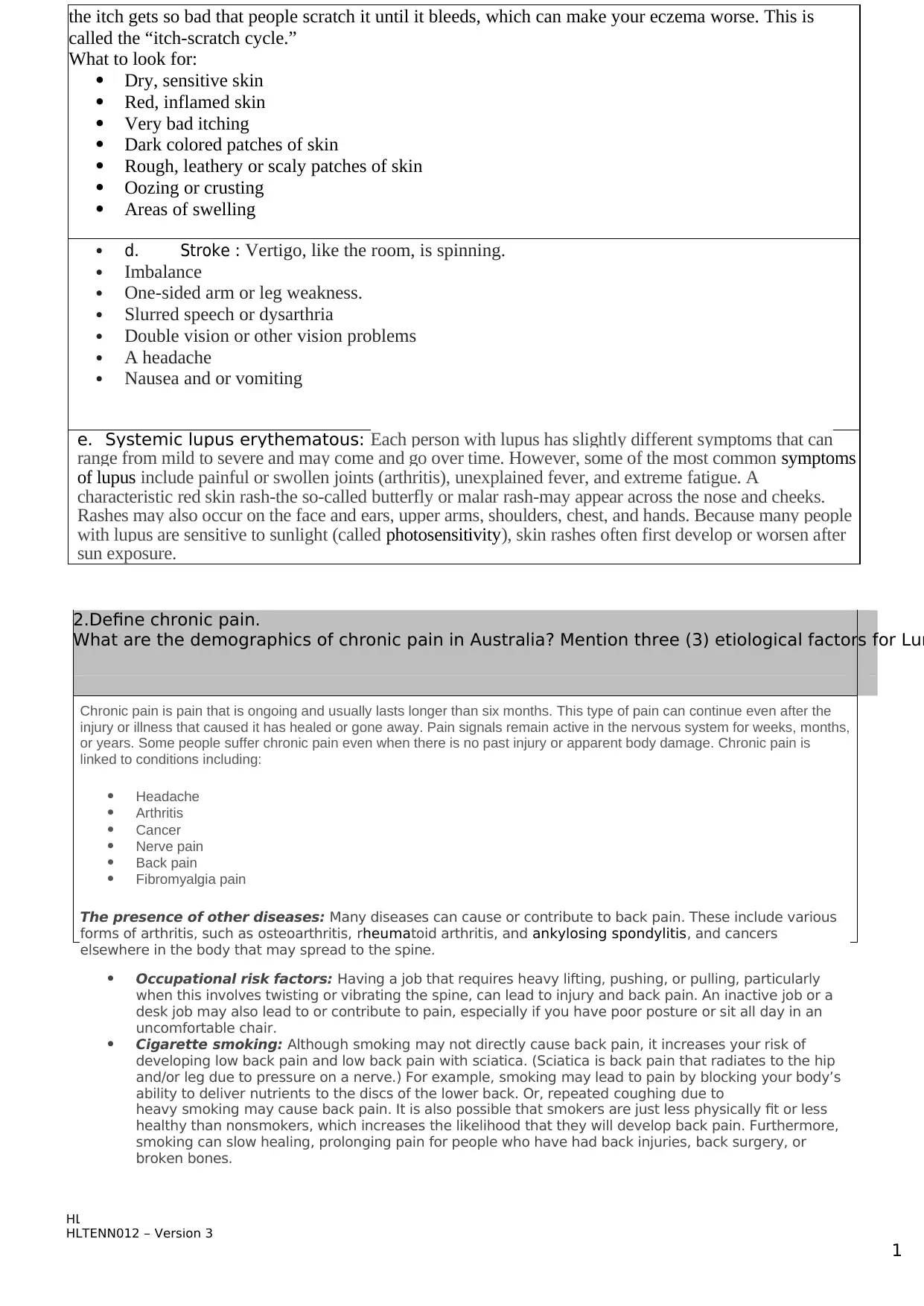
1
0
HLT54115 Diploma of Nursing
HLTENN012 – Version 3
January 2019
2.Define chronic pain.
What are the demographics of chronic pain in Australia? Mention three (3) etiological factors for Lum
the itch gets so bad that people scratch it until it bleeds, which can make your eczema worse. This is
called the “itch-scratch cycle.”
What to look for:
Dry, sensitive skin
Red, inflamed skin
Very bad itching
Dark colored patches of skin
Rough, leathery or scaly patches of skin
Oozing or crusting
Areas of swelling
d. Stroke : Vertigo, like the room, is spinning.
Imbalance
One-sided arm or leg weakness.
Slurred speech or dysarthria
Double vision or other vision problems
A headache
Nausea and or vomiting
e. Systemic lupus erythematous: Each person with lupus has slightly different symptoms that can
range from mild to severe and may come and go over time. However, some of the most common symptoms
of lupus include painful or swollen joints (arthritis), unexplained fever, and extreme fatigue. A
characteristic red skin rash-the so-called butterfly or malar rash-may appear across the nose and cheeks.
Rashes may also occur on the face and ears, upper arms, shoulders, chest, and hands. Because many people
with lupus are sensitive to sunlight (called photosensitivity), skin rashes often first develop or worsen after
sun exposure.
Chronic pain is pain that is ongoing and usually lasts longer than six months. This type of pain can continue even after the
injury or illness that caused it has healed or gone away. Pain signals remain active in the nervous system for weeks, months,
or years. Some people suffer chronic pain even when there is no past injury or apparent body damage. Chronic pain is
linked to conditions including:
Headache
Arthritis
Cancer
Nerve pain
Back pain
Fibromyalgia pain
The presence of other diseases: Many diseases can cause or contribute to back pain. These include various
forms of arthritis, such as osteoarthritis, rheumatoid arthritis, and ankylosing spondylitis, and cancers
elsewhere in the body that may spread to the spine.
Occupational risk factors: Having a job that requires heavy lifting, pushing, or pulling, particularly
when this involves twisting or vibrating the spine, can lead to injury and back pain. An inactive job or a
desk job may also lead to or contribute to pain, especially if you have poor posture or sit all day in an
uncomfortable chair.
Cigarette smoking: Although smoking may not directly cause back pain, it increases your risk of
developing low back pain and low back pain with sciatica. (Sciatica is back pain that radiates to the hip
and/or leg due to pressure on a nerve.) For example, smoking may lead to pain by blocking your body’s
ability to deliver nutrients to the discs of the lower back. Or, repeated coughing due to
heavy smoking may cause back pain. It is also possible that smokers are just less physically fit or less
healthy than nonsmokers, which increases the likelihood that they will develop back pain. Furthermore,
smoking can slow healing, prolonging pain for people who have had back injuries, back surgery, or
broken bones.
0
HLT54115 Diploma of Nursing
HLTENN012 – Version 3
January 2019
2.Define chronic pain.
What are the demographics of chronic pain in Australia? Mention three (3) etiological factors for Lum
the itch gets so bad that people scratch it until it bleeds, which can make your eczema worse. This is
called the “itch-scratch cycle.”
What to look for:
Dry, sensitive skin
Red, inflamed skin
Very bad itching
Dark colored patches of skin
Rough, leathery or scaly patches of skin
Oozing or crusting
Areas of swelling
d. Stroke : Vertigo, like the room, is spinning.
Imbalance
One-sided arm or leg weakness.
Slurred speech or dysarthria
Double vision or other vision problems
A headache
Nausea and or vomiting
e. Systemic lupus erythematous: Each person with lupus has slightly different symptoms that can
range from mild to severe and may come and go over time. However, some of the most common symptoms
of lupus include painful or swollen joints (arthritis), unexplained fever, and extreme fatigue. A
characteristic red skin rash-the so-called butterfly or malar rash-may appear across the nose and cheeks.
Rashes may also occur on the face and ears, upper arms, shoulders, chest, and hands. Because many people
with lupus are sensitive to sunlight (called photosensitivity), skin rashes often first develop or worsen after
sun exposure.
Chronic pain is pain that is ongoing and usually lasts longer than six months. This type of pain can continue even after the
injury or illness that caused it has healed or gone away. Pain signals remain active in the nervous system for weeks, months,
or years. Some people suffer chronic pain even when there is no past injury or apparent body damage. Chronic pain is
linked to conditions including:
Headache
Arthritis
Cancer
Nerve pain
Back pain
Fibromyalgia pain
The presence of other diseases: Many diseases can cause or contribute to back pain. These include various
forms of arthritis, such as osteoarthritis, rheumatoid arthritis, and ankylosing spondylitis, and cancers
elsewhere in the body that may spread to the spine.
Occupational risk factors: Having a job that requires heavy lifting, pushing, or pulling, particularly
when this involves twisting or vibrating the spine, can lead to injury and back pain. An inactive job or a
desk job may also lead to or contribute to pain, especially if you have poor posture or sit all day in an
uncomfortable chair.
Cigarette smoking: Although smoking may not directly cause back pain, it increases your risk of
developing low back pain and low back pain with sciatica. (Sciatica is back pain that radiates to the hip
and/or leg due to pressure on a nerve.) For example, smoking may lead to pain by blocking your body’s
ability to deliver nutrients to the discs of the lower back. Or, repeated coughing due to
heavy smoking may cause back pain. It is also possible that smokers are just less physically fit or less
healthy than nonsmokers, which increases the likelihood that they will develop back pain. Furthermore,
smoking can slow healing, prolonging pain for people who have had back injuries, back surgery, or
broken bones.
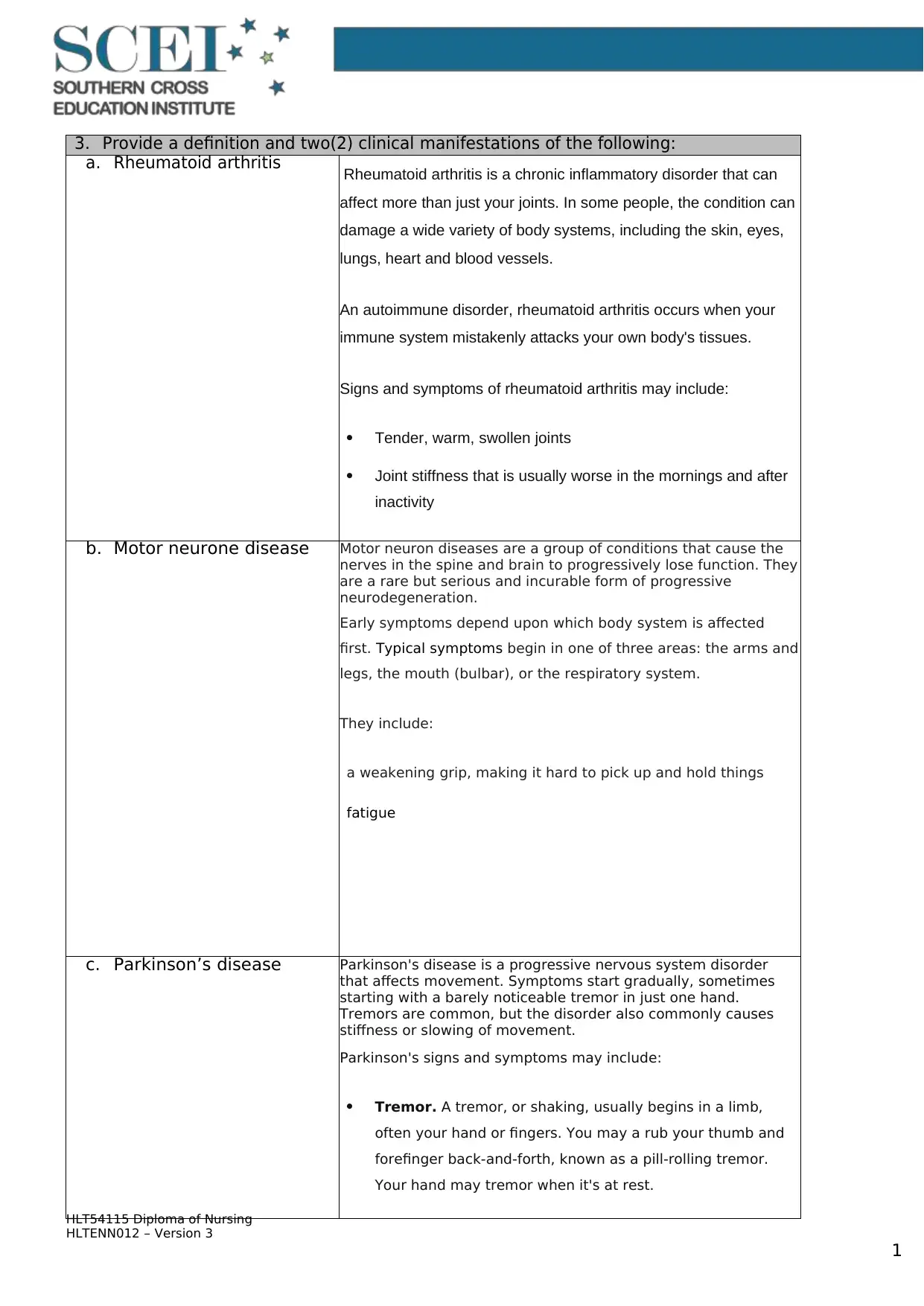
HLT54115 Diploma of Nursing
HLTENN012 – Version 3
January 2019 1
1
3. Provide a definition and two(2) clinical manifestations of the following:
a. Rheumatoid arthritis Rheumatoid arthritis is a chronic inflammatory disorder that can
affect more than just your joints. In some people, the condition can
damage a wide variety of body systems, including the skin, eyes,
lungs, heart and blood vessels.
An autoimmune disorder, rheumatoid arthritis occurs when your
immune system mistakenly attacks your own body's tissues.
Signs and symptoms of rheumatoid arthritis may include:
Tender, warm, swollen joints
Joint stiffness that is usually worse in the mornings and after
inactivity
b. Motor neurone disease Motor neuron diseases are a group of conditions that cause the
nerves in the spine and brain to progressively lose function. They
are a rare but serious and incurable form of progressive
neurodegeneration.
Early symptoms depend upon which body system is affected
first. Typical symptoms begin in one of three areas: the arms and
legs, the mouth (bulbar), or the respiratory system.
They include:
a weakening grip, making it hard to pick up and hold things
fatigue
c. Parkinson’s disease Parkinson's disease is a progressive nervous system disorder
that affects movement. Symptoms start gradually, sometimes
starting with a barely noticeable tremor in just one hand.
Tremors are common, but the disorder also commonly causes
stiffness or slowing of movement.
Parkinson's signs and symptoms may include:
Tremor. A tremor, or shaking, usually begins in a limb,
often your hand or fingers. You may a rub your thumb and
forefinger back-and-forth, known as a pill-rolling tremor.
Your hand may tremor when it's at rest.
HLTENN012 – Version 3
January 2019 1
1
3. Provide a definition and two(2) clinical manifestations of the following:
a. Rheumatoid arthritis Rheumatoid arthritis is a chronic inflammatory disorder that can
affect more than just your joints. In some people, the condition can
damage a wide variety of body systems, including the skin, eyes,
lungs, heart and blood vessels.
An autoimmune disorder, rheumatoid arthritis occurs when your
immune system mistakenly attacks your own body's tissues.
Signs and symptoms of rheumatoid arthritis may include:
Tender, warm, swollen joints
Joint stiffness that is usually worse in the mornings and after
inactivity
b. Motor neurone disease Motor neuron diseases are a group of conditions that cause the
nerves in the spine and brain to progressively lose function. They
are a rare but serious and incurable form of progressive
neurodegeneration.
Early symptoms depend upon which body system is affected
first. Typical symptoms begin in one of three areas: the arms and
legs, the mouth (bulbar), or the respiratory system.
They include:
a weakening grip, making it hard to pick up and hold things
fatigue
c. Parkinson’s disease Parkinson's disease is a progressive nervous system disorder
that affects movement. Symptoms start gradually, sometimes
starting with a barely noticeable tremor in just one hand.
Tremors are common, but the disorder also commonly causes
stiffness or slowing of movement.
Parkinson's signs and symptoms may include:
Tremor. A tremor, or shaking, usually begins in a limb,
often your hand or fingers. You may a rub your thumb and
forefinger back-and-forth, known as a pill-rolling tremor.
Your hand may tremor when it's at rest.
⊘ This is a preview!⊘
Do you want full access?
Subscribe today to unlock all pages.

Trusted by 1+ million students worldwide
1 out of 40
Related Documents
Your All-in-One AI-Powered Toolkit for Academic Success.
+13062052269
info@desklib.com
Available 24*7 on WhatsApp / Email
![[object Object]](/_next/static/media/star-bottom.7253800d.svg)
Unlock your academic potential
Copyright © 2020–2025 A2Z Services. All Rights Reserved. Developed and managed by ZUCOL.





